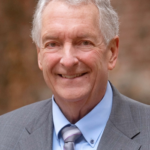Suppose you are a senior business, finance, or HR leader. In that case, you have likely already been asked to share your organization’s commitment to and investment in human capability (talent + leadership + organization + HR) (see Figure 1 for definition).
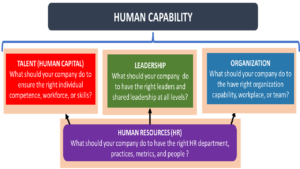
Figure 1. Overview of Human Capability
What will you say, and to whom will you say it so that your response increases confidence in your organization?
Human Capability Matters
The conversation about human capability is becoming increasingly important to an expanding set of stakeholders:
- Investors worry more than ever about intangible value, which represents up to 80 percent of your company’s market value (and reduction of risk). Our research shows that 25–30 percent of that 80 percent is tied to human capability.
Table 1. Investor Criteria for and Assessment of Intangible Value
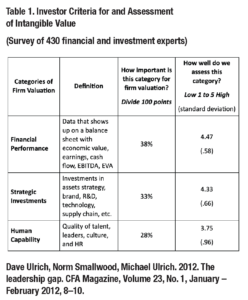
- Customers select products and services based on price, product features, and service culture. Service that comes from relationships between employees and customers is a significant differentiator when competitors can match prices and features. Employee experience is often a leading indicator of customer experience.
- Communities—broadly defined as regulators, citizens, education, and media—assess organization reputations for the environment (climate change), philanthropy (donations), and social agenda (DEI) that are often embedded in people and organization practices. These public reports include annual requirements to report human capital in SEC disclosures and increased social media platforms that share company ratings (e.g., Glassdoor, Most Admired, and Top Company lists).
- Boards of directors traditionally examine financial performance and strategic investments in every meeting. Increasingly, human capability issues are not just annual succession planning or compensation reviews but part of every board meeting.
- Senior executives increasingly recognize that talent determines long-term success and talent issues (workforce, retention, engagement). Top surveys of CEO concerns and conferences (World Economic Summit, WOBI, etc.)
- Employees who feel they have more choice want to work for a company where leaders care, have more control over their work setting, and are proud of the reputation and results the organization delivers to all stakeholders.
- HR professionals find meaning in their work as architects who design and deliver a human capability agenda that creates value for all stakeholders.
Because human capability investments and reporting create value for each stakeholder (see Figure 2), human capability reporting needs to improve.
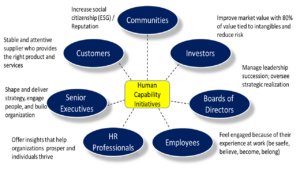
Figure 2. What do stakeholders need that human capability offers?
Current and Future State of Human Capability Investment and Reporting
To respond to human capability requirements, we envision changes in the content of what is reported and the process for how information is accessed.
Content. Content is about what stakeholders pay attention to. However, often human capability discussions are based on analytics that is not integrated:
- People look at isolated HR practices, e.g., time to hire, percent promoted from within, turnover/retention, or diversity indices.
- Activity-focused. Analytics focuses on what is done, e.g., the number of employees, days of training or training budget, or CEO pay ratio.
- Demographics. Reports are done on the distribution of age, education, race, gender, and other demographics.
Considering the impact of human capability on business results, we propose that stakeholders receive more rigorous content that is:
- Rely on a typology of integrated HR initiatives using a theory of classification. The human capability logic in Figure 1 shows how 38 initiatives clustered into four categories of talent, leadership, organization, and HR.
- Actionable. Instead of demographics and activities, offer stakeholders information that helps them make prescriptive investments in initiatives.
- Impact follows a portfolio logic where initiatives impact stakeholder outcomes differently and prioritizes which of the 38 initiatives will deliver more value to stakeholders. Research without action is like reading how to do a hobby book but never doing it.
Process. Process refers to how information is collected. Trusting the data collected is necessary for stakeholders to have confidence in actionable insights. We see four common approaches to managing information:
- Leaders know something when they see and feel it. As ethnographers, leaders can learn to pay attention to their experiences. They can “feel” how an organization is or is not working within a short time.
- One-on-one (or team) interviews allow in-depth conversations to pursue and explore issues of interest. Interviews often uncover underlying problems that may be causing symptoms.
- The most common data tool is a survey where questions are crafted and asked of targeted respondents (e.g., engagement, 360, climate). Surveys help with statistics that discover cause and effect and define patterns.
- Scaling through AI/machine learning. Numerous documents exist within or about an organization (10K, training, social media, texts, emails, and so forth). Using modern AI technology, these existing documents can be scored.
The difference between surveys vs. scaling can be illustrated with nutrition. On a survey, someone may say they are an “8 out of 10” when questioned about healthy eating. But with AI data, one could track what and how often someone buys food (store data), eats at a restaurant (with QR code), and exercises (with health monitors). This AI-enabled data could lead to a behavior-based score (1 to 10) on healthy eating, which is more accurate than a perception of healthy eating.
When organizations have a comprehensive framework for human capability with scalable analytics, stakeholders have insights on the human capacity that lead to actionable insights.
Example of Emerging Human Capability Reporting
We have scored the human capital reporting required by the Securities Exchange Commission (SEC) for 7,000 US firms using 2021 and 2022 data. We scored each of the four human capability pathways. For a review of this methodology, see https://bit.ly/43VxxzH.
Table 2 shows the remarkable finding that the “human capital” information reported in 2021 and 2022 has identical scores. This data reflects that the reported messages about human capability have not changed between these two years. We find that the processes and roles used to craft these messages are not evolving. Even though stakeholders want better human capital information, they are not receiving it. This consistency represents an enormous opportunity for differentiation if a firm can offer a more rigorous and reliable report on human capability than others in their industry.
Table 2. SEC Human Capability Scores 2021 and 2022
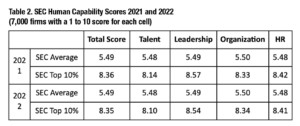
(7,000 firms with a 1 to 10 score for each cell)
With this large database and AI methodology, we found that the total human capability score explained 26 percent of cash flow and 25 percent of investor confidence, which is remarkably consistent with the findings in Table 1 from our earlier survey of investors.
Diagnose Your Human Capability Efforts
To improve building and to report better human capability, we have used the diagnostic in Table 3 to help focus attention on steps to enhance human capability efforts. The line in the scoring box is the typical pattern in answers we receive, with higher importance rated higher than effectiveness, effectiveness higher than clarity, and so on.
Table 3. Human Capability Diagnostic
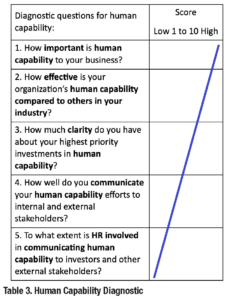
Actions for Improving Human Capability Investments and Reporting
To respond to requests by all stakeholders for more information on human capability, we propose actions for each of the five diagnostic questions (see Table 4).
Table 4:
Human Capability Improvement and Reporting Actions
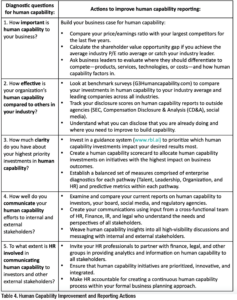
Conclusion
We expect human capability reporting to become more like financial reporting in the future because of human capability’s impact on all stakeholders. So, rather than be hesitant or offer piecemeal information about work in human capability, we encourage business, finance, and HR leaders to improve their human capability efforts to increase stakeholder confidence.
References
Talent determines long-term success, hkps://bit.ly/43TUKlL
A system for analyzing human capability at scale using AI, hkps://bit.ly/43VxxzH
